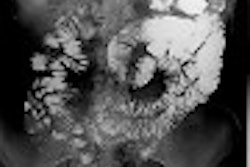SALT LAKE CITY - Interventional radiologists at the UT-Southwestern Medical Center in Dallas are relying almost exclusively on CT angiography assessment of patients with abdominal aortic aneurysm (AAA) prior to performing endografts. Dr. Bart Dolmatch presented his group’s work Saturday at the Society of Interventional Radiology (SIR) meeting.
"The goal of pre-endograft imaging is for appropriate patient selection, device selection, device sizing, and finally, planning the approach for endograft delivery," Dolmatch said. "Catheter angiography is considered a complement to spiral CT…and I think at most places, they still use catheter angiography quite liberally."
In a retrospective review, the group looked at all patients with AAA who had undergone CT angiography (CTA), with or without digital subtraction angiography (DSA) over a 17-month period. CTA was performed on an Aquilion 4-slice scanner (Toshiba America Medical Systems, Tustin, CA) with 3-mm collimation, 1.5-mm spacing, 120 kVp, and 250-350 mAs. A Vitrea-2 workstation (Vital Images, Plymouth, MN) was used for multiplanar reformation and 3-D volume renderings.
"What do we measure (with imaging)? We measure diameter, including the aortic neck and the iliac artery. (We measure) the length of the aortic neck including the abdominal aortic sack and the iliac artery. Finally, the angles of the aortic neck," Dolmatch explained.
Dolmatch also offered some details of his group’s CTA reconstruction protocol. For diameter measures, he said, they correct for obliquity with off-axis planes that cut perpendicular to the artery. Meanwhile, length is measured on curved planes, while anterioposterior and lateral angles are measured from the sagittal and coronal plane reconstructions.
The CTA exam took 30-45 minutes, but many patients could be excluded as endograft candidates based on initial CT measurements, he noted. The disqualification criteria included AAA with a diameter that was too small; AAA in which the proximal neck was too dilated, too short, or too angulated; juxtarenal or higher AAA; and other iliac artery complications.
The endograft group was then divided into patients with preoperative CTA and those who underwent CTA and DSA. Both groups were reviewed for operative and postoperative outcomes, including early and late endoleaks, unanticipated intraoperative findings, and adjunctive procedures in the operating room.
Of the 55 patients, 21 underwent endograft, 29 were excluded, and 5 were eligible for endograft but had not undergone the procedure when the study closed. Of the 21 patients who underwent endograft, 13 had CTA as the sole preoperative angiogram, while 9 had both CTA and DSA.
No intraoperative difficulties were encountered in either group, and none of the patients required a conversion to open surgery. Nor were any unanticipated procedures performed in either group, Dolmatch reported. However, CTA did predict the need for the following: placement of one renal stent; one embolization; one iliac angioplasty; embolization of two arteries; one accessory renal; and one hypogastric.
In an update of the previous results, Dolmatch said his group has now assessed 9 more AAA patients with CTA alone, for a total of 22 patients. The results were just as successful: All patients underwent endograft, and CTA also revealed 4 cases of iliac artery stenoses that required intraoperative angioplasty. On 1-6 month CTA follow-up, there were no device migrations and only 2 cases of leaks, he said.
"We see a devolving role for (catheter) angiography. We regard angiography as something that can be used to resolve issues of anatomy and vessel patency," Dolmatch concluded.
By Shalmali Pal
AuntMinnie.com staff writer
March 30, 2003
Copyright © 2003 AuntMinnie.com




















